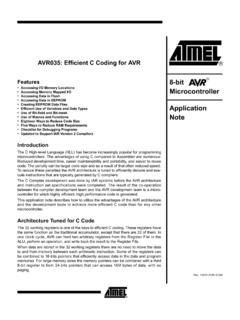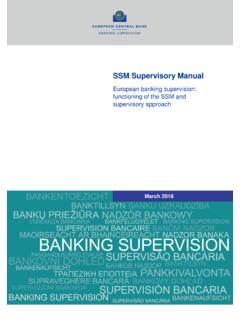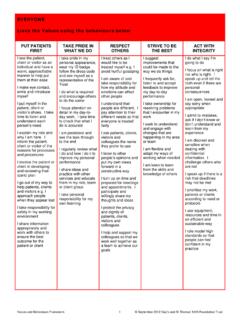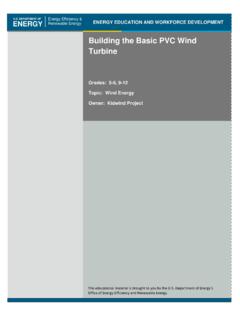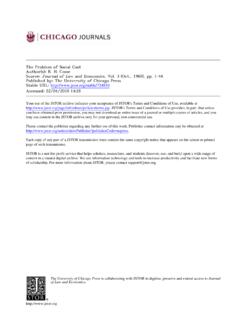Transcription of arXiv:1512.00567v3 [cs.CV] 11 Dec 2015
1 Rethinking the Inception Architecture for Computer VisionChristian SzegedyGoogle WojnaUniversity College networks are at the core of most state-of-the-art computer vision solutions for a wide variety oftasks. Since 2014 very deep convolutional networks startedto become mainstream, yielding substantial gains in vari-ous benchmarks. Although increased model size and com-putational cost tend to translate to immediate quality gainsfor most tasks (as long as enough labeled data is providedfor training), computational efficiency and low parametercount are still enabling factors for various use cases such asmobile vision and big-data scenarios. Here we are explor-ing ways to scale up networks in ways that aim at utilizingthe added computation as efficiently as possible by suitablyfactorized convolutions and aggressive regularization. Webenchmark our methods on the ILSVRC 2012 classificationchallenge validation set demonstrate substantial gains overthe state of the forsingle frame evaluation using a network with a computa-tional cost of5billion multiply-adds per inference and withusing less than 25 million parameters.
2 With an ensemble of4models and multi-crop evaluation, we IntroductionSince the 2012 ImageNet competition [16] winning en-try by Krizhevsky et al [9], their network AlexNet hasbeen successfully applied to a larger variety of computervision tasks, for example to object-detection [5], segmen-tation [12], human pose estimation [22], video classifica-tion [8], object tracking [23], and superresolution [3].These successes spurred a new line of research that fo-cused on finding higher performing convolutional neuralnetworks. Starting in 2014, the quality of network architec-tures significantly improved by utilizing deeper and widernetworks. VGGNet [18] and GoogLeNet [20] yielded simi-larly high performance in the 2014 ILSVRC [16] classifica-tion challenge. One interesting observation was that gainsin the classification performance tend to transfer to signifi-cant quality gains in a wide variety of application means that architectural improvements in deep con-volutional architecture can be utilized for improving perfor-mance for most other computer vision tasks that are increas-ingly reliant on high quality, learned visual features.
3 Also,improvements in the network quality resulted in new appli-cation domains for convolutional networks in cases whereAlexNet features could not compete with hand engineered,crafted solutions, proposal generation in detection[4].Although VGGNet [18] has the compelling feature ofarchitectural simplicity, this comes at a high cost: evalu-ating the network requires a lot of computation. On theother hand, the Inception architecture of GoogLeNet [20]was also designed to perform well even under strict con-straints on memory and computational budget. For exam-ple, GoogleNet employed only 5 million parameters, whichrepresented a12 reduction with respect to its predeces-sor AlexNet, which used60million parameters. Further-more, VGGNet employed about 3x more parameters computational cost of Inception is also much lowerthan VGGNet or its higher performing successors [6]. Thishas made it feasible to utilize Inception networks in big-datascenarios[17], [13], where huge amount of data needed tobe processed at reasonable cost or scenarios where memoryor computational capacity is inherently limited, for examplein mobile vision settings.
4 It is certainly possible to mitigateparts of these issues by applying specialized solutions to tar-get memory use [2], [15] or by optimizing the execution ofcertain operations via computational tricks [10]. However,these methods add extra complexity. Furthermore, thesemethods could be applied to optimize the Inception archi-tecture as well, widening the efficiency gap , the complexity of the Inception architecture makes1 [ ] 11 Dec 2015it more difficult to make changes to the network. If the ar-chitecture is scaled up naively, large parts of the computa-tional gains can be immediately lost. Also, [20] does notprovide a clear description about the contributing factorsthat lead to the various design decisions of the GoogLeNetarchitecture. This makes it much harder to adapt it to newuse-cases while maintaining its efficiency. For example,if it is deemed necessary to increase the capacity of someInception-style model, the simple transformation of justdoubling the number of all filter bank sizes will lead to a4x increase in both computational cost and number of pa-rameters.
5 This might prove prohibitive or unreasonable in alot of practical scenarios, especially if the associated gainsare modest. In this paper, we start with describing a fewgeneral principles and optimization ideas that that provedto be useful for scaling up convolution networks in efficientways. Although our principles are not limited to Inception-type networks, they are easier to observe in that context asthe generic structure of the Inception style building blocksis flexible enough to incorporate those constraints is enabled by the generous use of dimensional reduc-tion and parallel structures of the Inception modules whichallows for mitigating the impact of structural changes onnearby components. Still, one needs to be cautious aboutdoing so, as some guiding principles should be observed tomaintain high quality of the General Design PrinciplesHere we will describe a few design principles basedon large-scale experimentation with various architecturalchoices with convolutional networks.
6 At this point, the util-ity of the principles below are speculative and additionalfuture experimental evidence will be necessary to assesstheir accuracy and domain of validity. Still, grave devia-tions from these principles tended to result in deteriorationin the quality of the networks and fixing situations wherethose deviations were detected resulted in improved archi-tectures in Avoid representational bottlenecks, especially early inthe network. Feed-forward networks can be repre-sented by an acyclic graph from the input layer(s) tothe classifier or regressor. This defines a clear directionfor the information flow. For any cut separating the in-puts from the outputs, one can access the amount ofinformation passing though the cut. One should avoidbottlenecks with extreme compression. In general therepresentation size should gently decrease from the in-puts to the outputs before reaching the final represen-tation used for the task at hand.
7 Theoretically, infor-mation content can not be assessed merely by the di-mensionality of the representation as it discards impor-tant factors like correlation structure; the dimensional-ity merely provides a rough estimate of Higher dimensional representations are easier to pro-cess locally within a network. Increasing the activa-tions per tile in a convolutional network allows formore disentangled features. The resulting networkswill train Spatial aggregation can be done over lower dimen-sional embeddings without much or any loss in rep-resentational power. For example, before performing amore spread out ( 3) convolution, one can re-duce the dimension of the input representation beforethe spatial aggregation without expecting serious ad-verse effects. We hypothesize that the reason for thatis the strong correlation between adjacent unit resultsin much less loss of information during dimension re-duction, if the outputs are used in a spatial aggrega-tion context.
8 Given that these signals should be easilycompressible, the dimension reduction even promotesfaster Balance the width and depth of the network. Optimalperformance of the network can be reached by balanc-ing the number of filters per stage and the depth ofthe network. Increasing both the width and the depthof the network can contribute to higher quality net-works. However, the optimal improvement for a con-stant amount of computation can be reached if both areincreased in parallel. The computational budget shouldtherefore be distributed in a balanced way between thedepth and width of the these principles might make sense, it is notstraightforward to use them to improve the quality of net-works out of box. The idea is to use them judiciously inambiguous situations Factorizing Convolutions with Large FilterSizeMuch of the original gains of the GoogLeNet net-work [20] arise from a very generous use of dimension re-duction.
9 This can be viewed as a special case of factorizingconvolutions in a computationally efficient manner. Con-sider for example the case of a1 1convolutional layerfollowed by a3 3convolutional layer. In a vision net-work, it is expected that the outputs of near-by activationsare highly correlated. Therefore, we can expect that theiractivations can be reduced before aggregation and that thisshould result in similarly expressive local we explore other ways of factorizing convolutionsin various settings, especially in order to increase the com-putational efficiency of the solution. Since Inception net-works are fully convolutional, each weight corresponds toFigure 1. Mini-network replacing the5 multiplication per activation. Therefore, any reductionin computational cost results in reduced number of param-eters. This means that with suitable factorization, we canend up with more disentangled parameters and thereforewith faster training.
10 Also, we can use the computationaland memory savings to increase the filter-bank sizes of ournetwork while maintaining our ability to train each modelreplica on a single Factorization into smaller convolutionsConvolutions with larger spatial filters ( 5or7 7) tend to be disproportionally expensive in terms ofcomputation. For example, a5 5convolution withnfil-ters over a grid withmfilters is 25/9 = times morecomputationally expensive than a3 3convolution withthe same number of filters. Of course, a5 5filter can cap-ture dependencies between signals between activations ofunits further away in the earlier layers, so a reduction of thegeometric size of the filters comes at a large cost of expres-siveness. However, we can ask whether a5 5convolutioncould be replaced by a multi-layer network with less pa-rameters with the same input size and output depth. If wezoom into the computation graph of the5 5convolution,we see that each output looks like a small fully-connectednetwork sliding over5 5tiles over its input (see Figure 1).
![arXiv:0706.3639v1 [cs.AI] 25 Jun 2007](/cache/preview/4/1/3/9/3/1/4/b/thumb-4139314b93ef86b7b4c2d05ebcc88e46.jpg)

![arXiv:1301.3781v3 [cs.CL] 7 Sep 2013](/cache/preview/4/d/5/0/4/3/4/0/thumb-4d504340120163c0bdf3f4678d8d217f.jpg)
![@google.com arXiv:1609.03499v2 [cs.SD] 19 Sep 2016](/cache/preview/c/3/4/9/4/6/9/b/thumb-c349469b499107d21e221f2ac908f8b2.jpg)






